SHOP ALL
Browse everything in the shop
NEW IN SHOP
Shop latest additions
BESTSELLERS
Hottest trends and top selling
PRODUCT SUGGESTIONS
Have an idea? Let me know about it! ♥
Browse everything in the shop
Shop latest additions
Hottest trends and top selling
Have an idea? Let me know about it! ♥
In this tutorial we’re going to make some cute layerable eyeshadow with a cat eyeliner.
If you’ve never tried creating makeup, fear not! It’s really easy and fun to do.
First, let’s start with choosing a mesh head we like from Kloudust’s catalog.
Note: There are other heads in the catalog that have makeup versions of the head, but for this tutorial I am going to stick to Kloudust’s heads because they are the most popular and you can easily make them fit other popular heads from this creator.
I am going with Zell which is one of the most popular heads out there and it looks really cute too.

There are several results for “Zell” and this is because some are heads and the other 2 products are what we’re interested in: the mask. This is important because we need to work with a layerable part that covers the head.

It will look similar to the image above. Now, because we are deriving from a mask and not from a head, the head in your outfit might clip with the mask. Switch to a Zell head so we can have maximum compatibility and see what we’re doing. I’m wearing Zell Ethereal Med no lash version in the screenshots posted.
2. Hide unused parts
Add a black opacity map to all the areas you do not want to use. Make sure you uncheck Use Blending when hiding the materials. This is a must because having blending on, even though there is a black opacity map, will affect the functionality of the product and it will cause clipping.
In my case, I want to make eyeshadow and some face enhancements and I prefer using the white material for this. The red material is for lips as you can see, the black material is for eye makeup and the last two materials 10 and 11 are for upper and lower lashes.
The red material would have been a better choice because it would allow for more quality, since the texture is only around the eyes, whereas the white mask is for the whole face. The eye mask could be a better choice for small makeup details such as glitter, shimmer, etc.

3. Open the UV map texture in your graphics program
My program of choice is Photoshop. The UV map textures are provided by Kloudust on each product page of heads. To access these, open the browser version of the shop and search for Kloudust, then select the mask for the head you want to create makeup for.
It will look similar to this:

4. Create a group layer
This will make our life much easier because we will be able to transform the makeup into an opacity map in an instant. You can do this by either clicking the folder button from the Layers window (fig 1), or go to Layer – New – Group (fig 2).


5. Create a new layer inside the group
We will add all layers that we will make inside the newly formed group for efficiency.
6. For better vision, add a layer full of color with low opacity over the UV map to make it easier to draw over it
I want to start by making some eyeliner and… I can’t see shit.

That’s why a layer full of color just over the background makes everything so much easier! I usually add a full white layer and lower its opacity enough to be able to see the UV lines and everything else I am working on.

7. Create a black wing around the upper part of the eye
Looking at the image above, you can see I added a line with a default brush.
This is what the cat eyeliner from above looks like on the avatar:
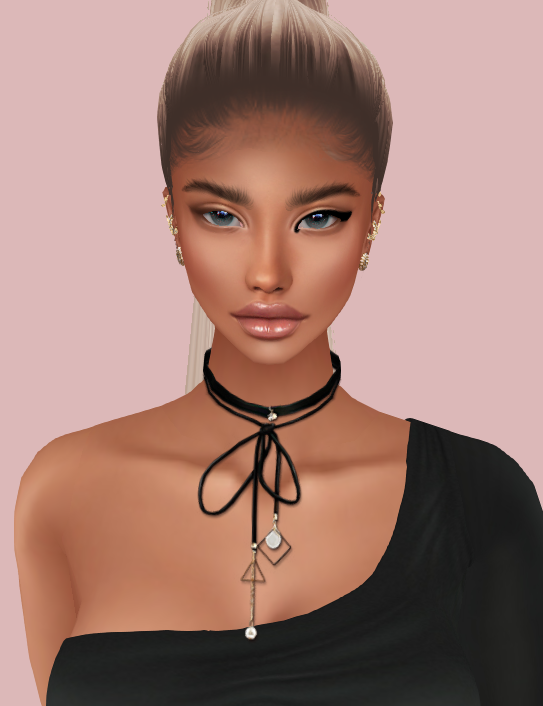
8. Make a new layer under the cat eyeliner to add shadow
I made the group layer orange to be easier to follow. The layer I am working on is under the cat eyeliner and I added a pink color around. I did this with a normal brush, then I went to Filter – Blur – Gaussian Blur and made the eyeshadow smoother.
After this, I selected the Burn Tool, set it to Midtones with an exposure of 70% and darkened the outer part of the eyeshadow. This is to create more depth.
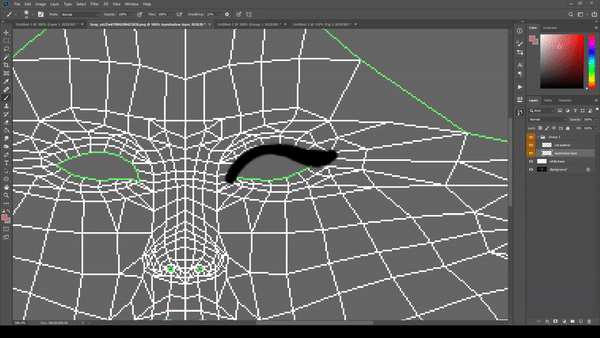
After adding the eyeshadow, the makeup looks like this:

9. Add more details to the eyeshadow
The progress so far looks decent, but let’s add more color and more details to the eyeshadow. The eyeshadow itself can change the look of the eye completely. It can make it bigger, smaller, it can make the avatar look more of a specific race, anything is possible.
This process is no different than drawing an eye. The only exception is the fact that we cannot change the eye socket part, but we control everything around it.
I made my auxiliar white layer more prominent so I can focus more on the colors I am adding on the actual makeup, while still being able to see a tiny bit of the UV map.
I made a red cat eyeliner just above the black line because I wanted a smoother transition and it adds a bit more realism, then, I made a high arch to shape the eyes and give them some depth.
I blurred the arch made to make it look more natural, then I wanted to add shimmer to the middle part of the eyelid. I changed my auxiliary color to white because I couldn’t see where I was placing the shimmer.
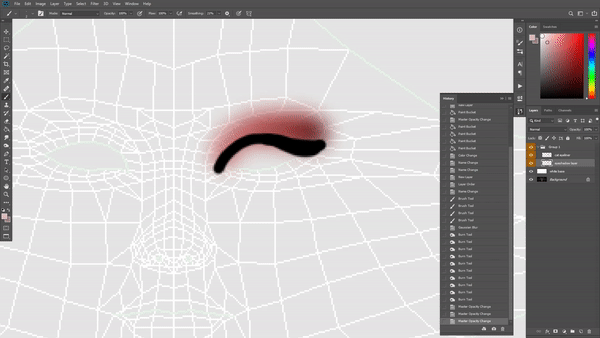
Next I added a purple line under the eye while experimenting with shades of purple and attempting to add a lighter shade of purple/pink in the inner part.

This is how the avatar looks like wearing our majestic makeup:

The blend of the purple part isn’t the greatest because it looks a bit messy and the eyeshadow on the upper lid looks decent, the only thing I find a bit off is the arch placement and the glitter that follows that shape. It looks quite unnatural.
I’m going back and merging all the layers so far, then trying to do a fast fix for the arch by using the Liquify tool.
Glitter is added by using a normal brush with a size of 1-2 pixels, then tapping them on the shiny lines to create more of a wet effect. I do this two times, the first time I add the sparks and set the layer to Overlay, then I create a new layer, add just a few more spots, but leave these white to add intensity to the shimmer.
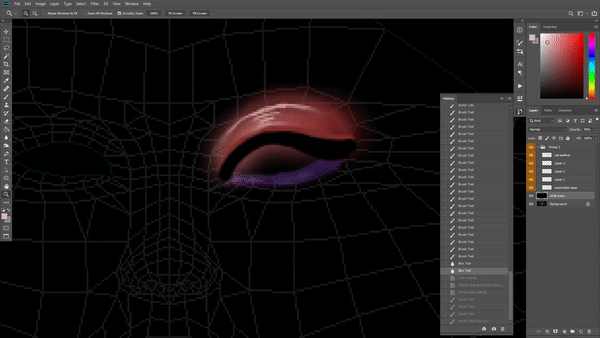
Here is how the makeup looks now:

While it is more intense, it does not necessarily mean it looks better. In fact, looking at the avatar, I’m not very happy with how prominent the purple on the lower part of the eye is, nor am I a fan of the slight cat liner part that drags the eye down a bit that together with the end part of the liner (which is arched upwards) create a feline look. Some might like it, but for me, it’s always trial by failure and redoing things until I am happy with how they look like.
10. Create the opacity map
Next, we’re going to fix the things mentioned not by coloring, but by creating the opacity map.
Since all of our layers are grouped together, we will easily transform the details created into an opacity map. To do this, right click the layer group, select Blending options, go to Color Overlay and set it to white with a full opacity (100%).

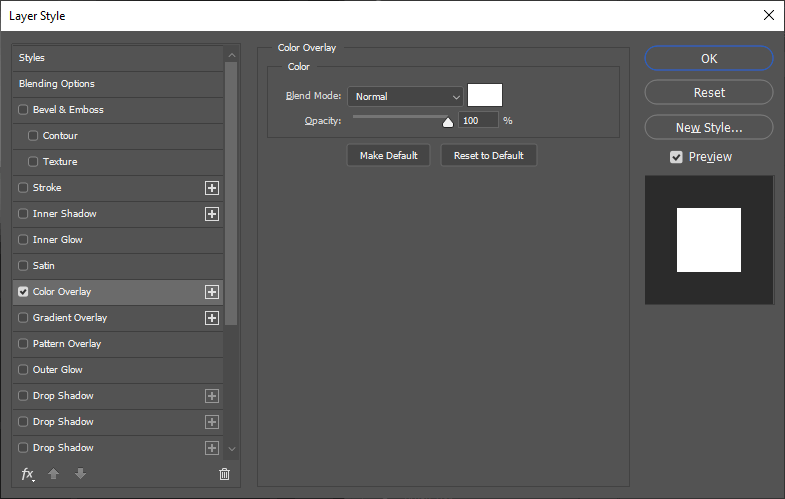
Our makeup will look something like this:

Next, add a black background with a full opacity.

Next, uncheck the group effects so we have our normal textures visible, then save the mask as a texture.


11. Add the texture and opacity map and make sure to have blending selected
We now have our opacity map! Make sure to add them by selecting “Use Blending”. This option is always needed when creating eyeshadow, otherwise it looks… weird.

This is how the avatar looks like right now:
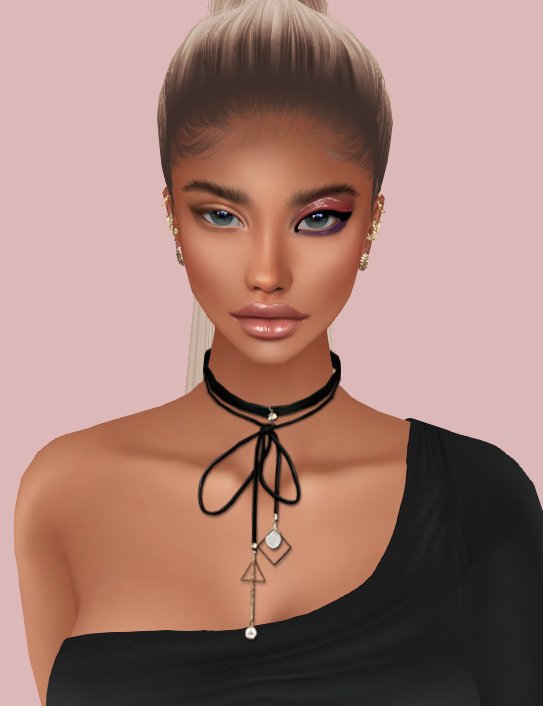
While it’s hardly noticeable for the untrained eye, we have some black/gray colors around the edges of our makeup. This is because we used the option Use Blending and this option always causes bleeding of the texture, meaning that it will make visible some parts that we didn’t really want to have added to the opacity map.
While the gray area around the eyes might look nice for some makeup styles, for many of them, it will ruin the beauty of the makeup created.
12. Improve the opacity map
Earlier I mentioned some mistakes that I wanted corrected, so I will edit the opacity map. I do this by using the Eraser tool and just cutting the edge of the cat eyeliner I don’t like, as well as cutting some of the eyeshadow that goes too far up.
I reworked the bottom liner by erasing the inner part and creating a gradient effect where the more closer to the outer edge of the eye, the prominent the color.

13. Improve the texture by coloring outside the makeup drawn
In most cases, due to the blending settings, the makeup colors have to be wider than just the opacity map. To make sure my pink eyeshadow remains a pink shade, I color the outer part of the upper eyeshadow in a pink shade and I also add more color around the purple. Why? Because I want the makeup to pick up specific colors, not the default black or the default background color I was working with.

The difference? No more gray area around the eye and I control the exact colors in the makeup.
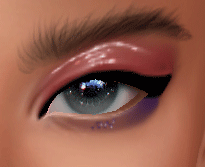
Steps 12 and 13 are what will differentiate a good creator from an excellent creator when it comes to creating makeup. These two steps can be applied for eye makeup, for freckles, for beauty marks, for face tattoos, for lips, anything that you can think of that you can paint on the face, I highly recommend making sure the opacity map correctly features the makeup desired and that you always color outside the makeup zone with the colors of the makeup. This way you control your makeup proficiently.
14. Duplicate the layer group to make the other eye
The way I do it is to work with one eye, then duplicate everything by right-clicking the group properties and selecting “Duplicate Group“.

Select the newly created group and go to Edit – Transform – Flip Horizontal and then I use the arrow keys to drag the layer more to the left. In this step I usually mess up the alignment and I have to test out the correct position of the eye several times, that’s why keeping the UV map visible helps a lot.
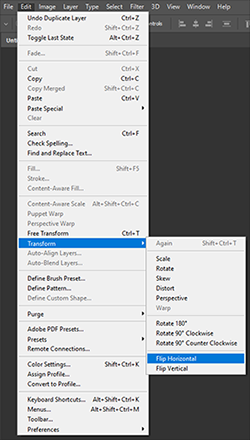
After that, make sure to re-do the opacity map for both eyes and since we duplicated the last functional layer group, all you need to do is re-enable the group settings to set everything to white, then add a full opacity black background.
You should end up with something like this:


Ta-da! Your first makeup is done! And because we worked efficiently with layers and layer groups, creating this exact makeup style for other heads will be simple. Every head has a different mask style, for some, you won’t need changes, for others you will, but the changes will usually be very small.
You can test out other heads you would like to create this makeup for. The trick to making it compatible with other heads is to drag the eye groups with small motions to the left, right, up, or down. That’s it, that’s how you will make your makeup compatible with other Kloudust heads.
Because the movement of the layers should be small, use the arrow keys on your keyboard. I do this by selecting the group of layers, then using my arrows and dragging the whole group to a different position.
It’s that simple!
Happy creating! ♥
No account yet?
Create an Account